How to Dehydrate Green Onions
This post may contain affiliate links, view our disclosure policy for details.
Drying green onions in the dehydrator is super easy! In this tutorial, I’ll show you how to dehydrate green onions, how to make green onion flakes, and how to make green onion powder.
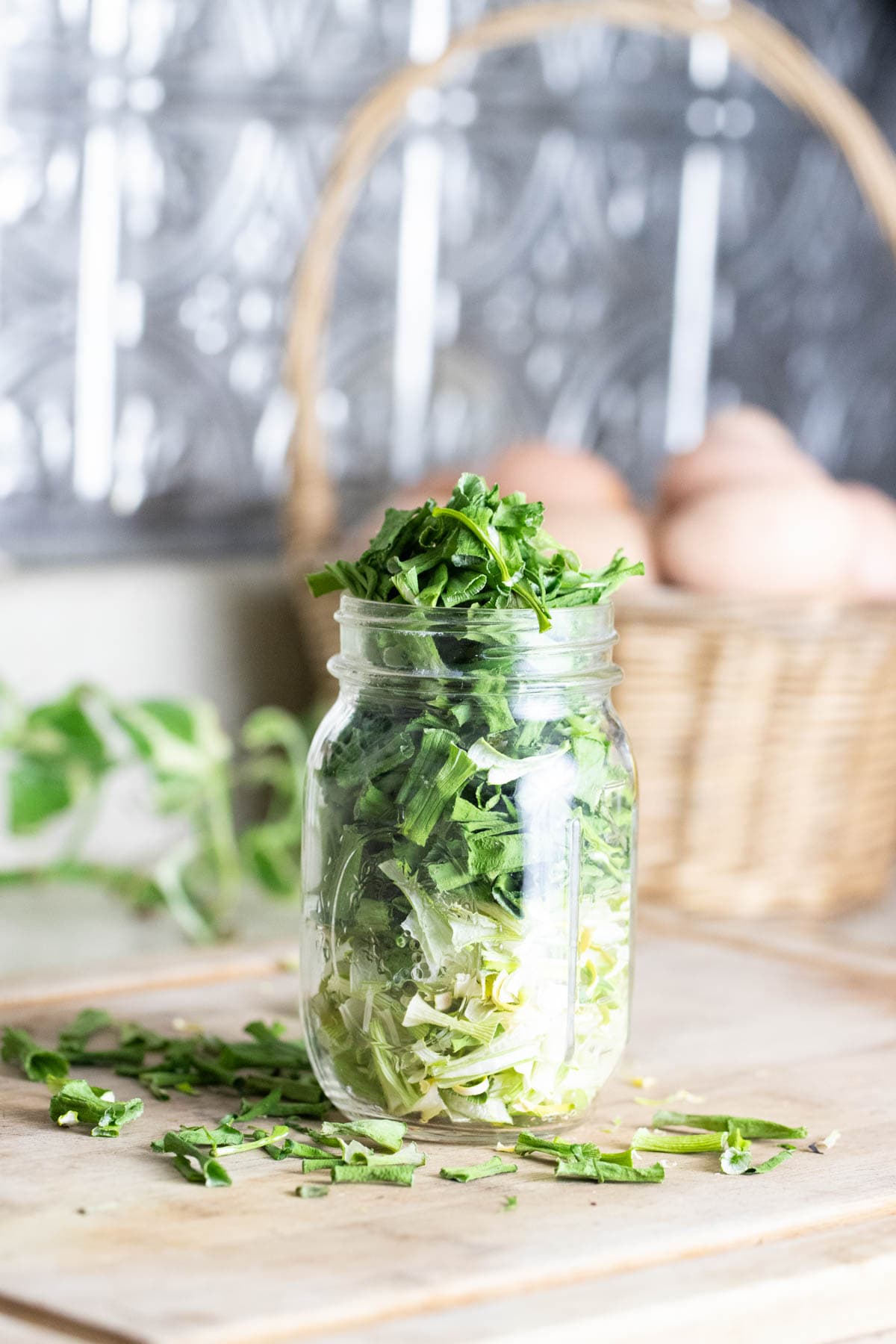
Lady Lee’s Note…
The world of dehydrating foods is new and fascinating to me. For a homesteader who grows a lot of food yet doesn’t have a proper root cellar, the thought of being able to store pretty much anything at room temperature for the long term is very appealing.
It’s kind of like canning, however, I think that the main difference is that it’s (usually) much less work. Dehydrating is also a great way to preserve herbs, greens, vegetables, and fruits that we can’t can (like rosemary, mint, watermelon, radish, bananas, and so on…)
Why Should You Dry Green Onions…
When I was thinking about what I would like to try to dehydrate first, green onions came to mind. They are also called scallions (scallions are basically young green onions) and they are pretty easy to grow. Even in a small space, you can grow a whole lot of green onions. I always have them in my garden and I often find myself at a loss as to what to do with all of them.
- Farm animals won’t eat them…
- We don’t often can them…
- They are not the greatest to freeze…
- And they won’t last too long even in cold storage…
So if you’re asking me, when it comes to preserving green onions, dehydrating them is the best way to go! Here is why…
- They keep their taste
- They keep their beautiful color
- They’ll last forever in an air-tight container
- You can turn them into flakes or powder
- And there are a million ways to use them (you’ll find some ideas at the end of this tutorial).
Ingredients…
- Green onions or scallions– that’s all you’ll need! They can be scallions (young green onions) or older. They can be the skinny kind, or the kind that has a larger bulb, they can be white or they can be purple… It doesn’t matter, you can follow this dehydrating process for all types of green onions.
Kitchen Tools…
- Knife
- Cutting board
- Dehydrator (you’ll also find oven instructions below)
- Air tight storage container (I use jars)
Step-by-Step Instructions…
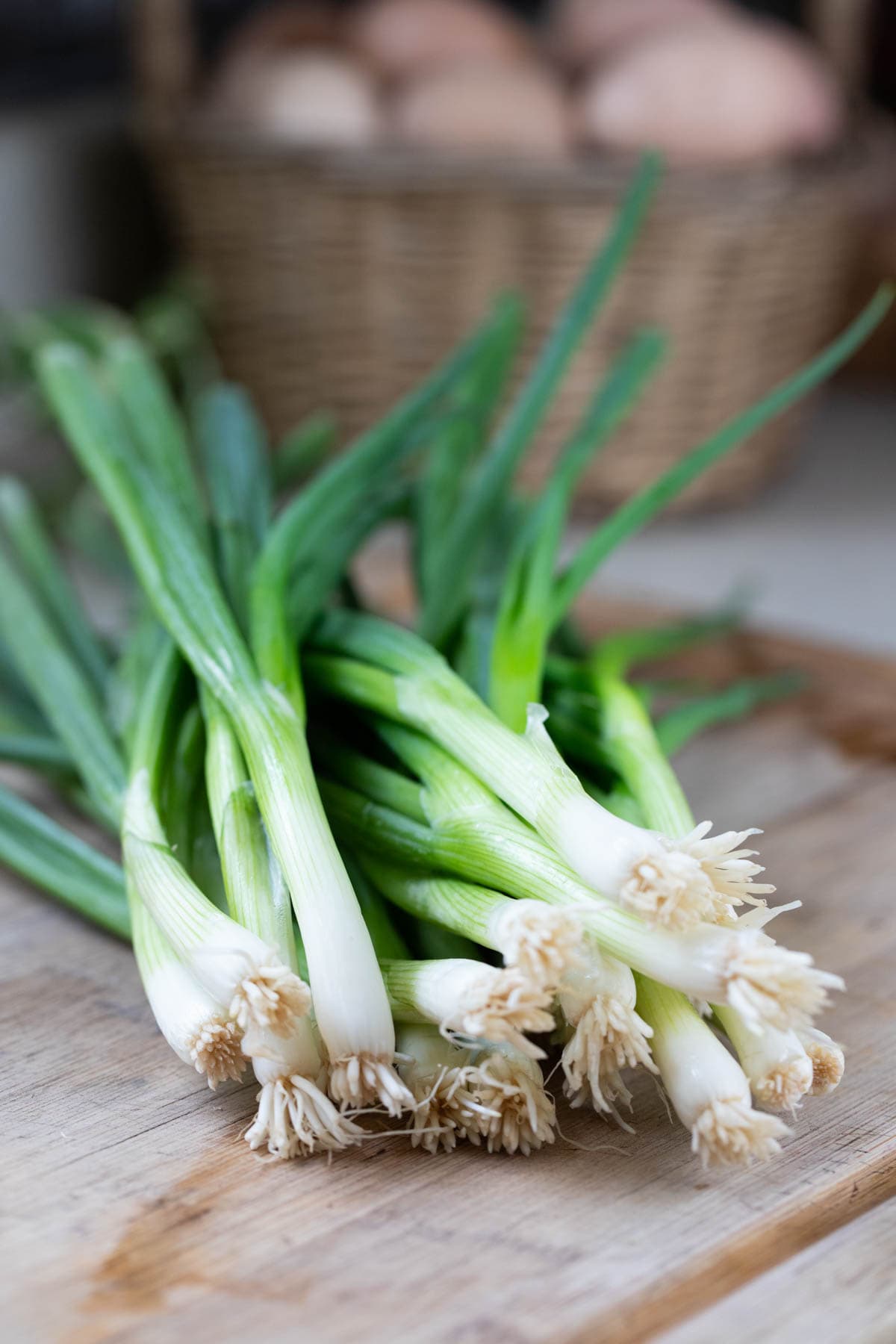

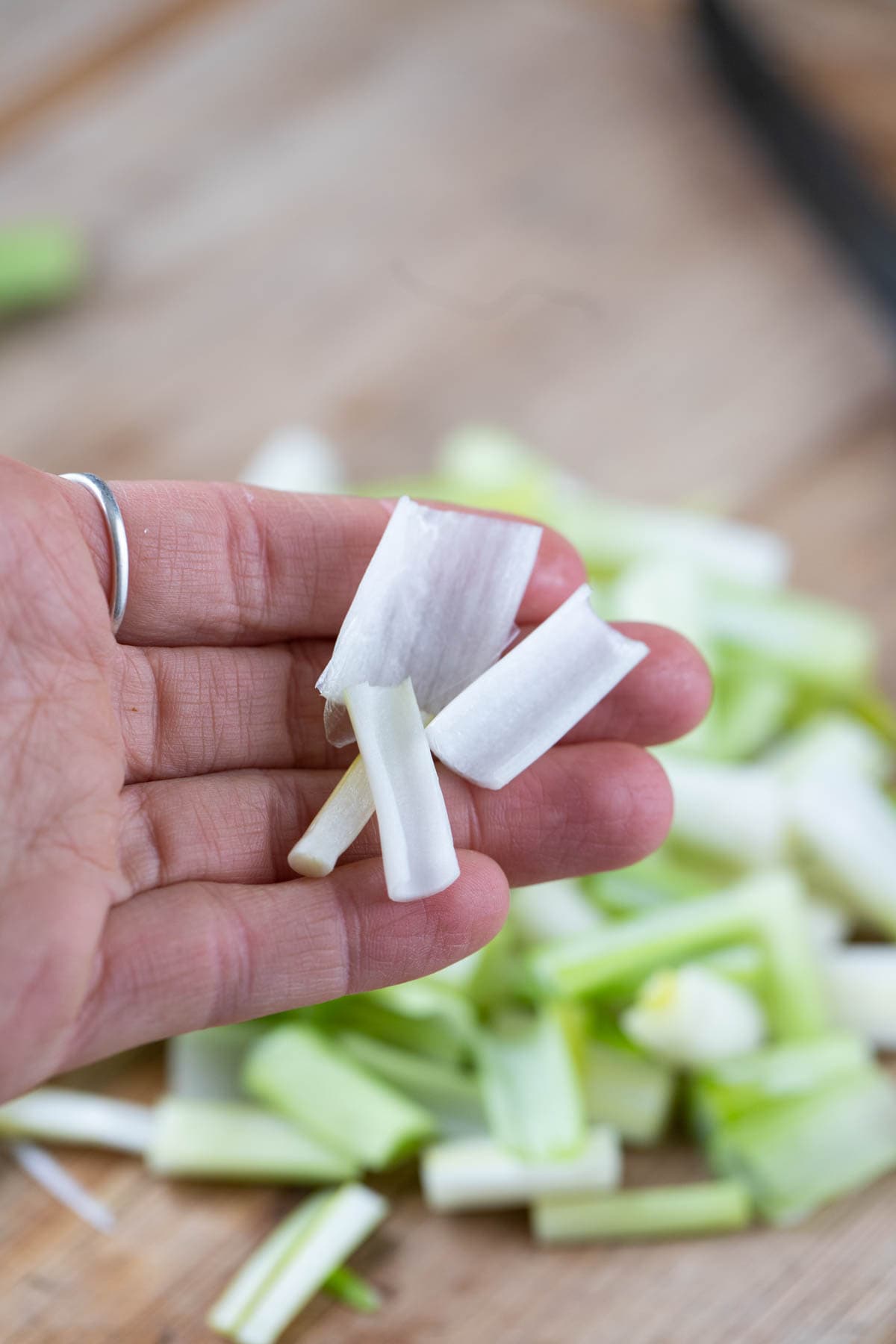

Step one – prep the onions. Preparing the onions for dehydrating is rather easy. First, wash the green onions and remove wilted or old leaves, then cut off the roots. I usually chop the onions into pieces that are 1/2 inch long. Since the white part is thicker than the green, I slice each piece lengthwise and separate the layers of the white part.
The bottom line is… You want your green onion pieces to be somewhat uniform so it takes them the same amount of time to dry in the dehydrator. You can slice them into rings or cut them any other way that you want, just try to make sure that they are somewhat uniform.
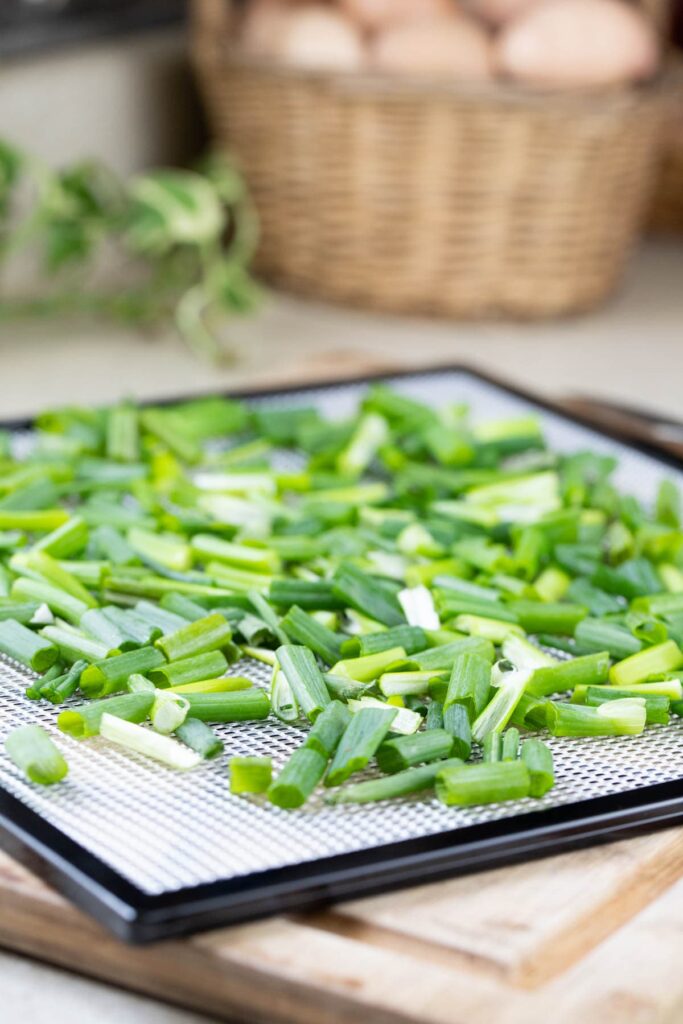
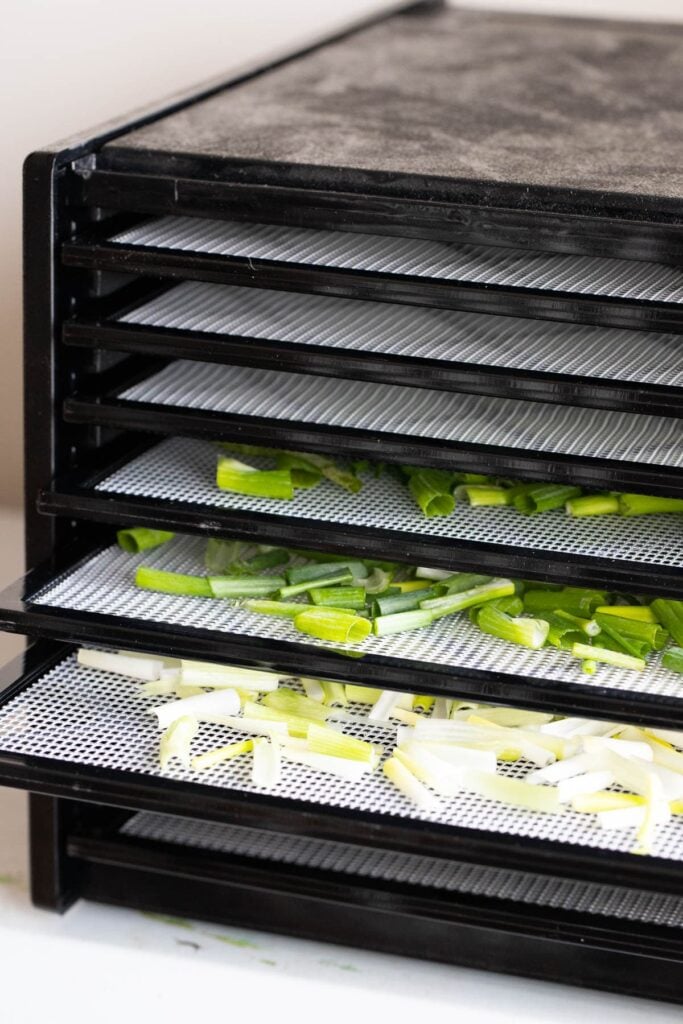
Step two – add to the dehydrator. It works best if you keep the white parts and the green parts of the onions separated since the white parts contain more moisture and it might take them a little longer to dehydrate. If you keep them separated you can remove the tray with the green tops and let the white bottoms tray stay in the dehydrator for a little while longer. So when you place the green onions on your dehydrator trays (in one layer), make sure to keep the two parts separated.

Step three – dehydrate. When it comes to dehydrating green onions, you have two options…
- Treat them as a vegetable – the recommended temperature for dehydrating vegetables is 125 degrees F. If you dry your green onions at this temperature it will probably take you 5-6 hours (this is how I dehydrate white or red onions).
- Treat them as an herb – many people (including myself) prefer treating green onions as an herb instead of a vegetable and choose to dehydrate green onions at a lower temperature for a longer period of time (like Rosemary, parsley, thyme or oregano, for example). This seems to help preserve the taste and color better. If you want to go this way, dry your green onions at a temperature of 100 degrees F for 7-9 hours.
Dehydrating Green Onions in the Oven…
- Prep the onions the same way I described above.
- Place them in one layer on a baking sheet lined with parchment paper.
- Preheat your oven to the lowest temperature. Many ovens these days have a drying option. If your oven has this option turn it to 125 degrees F or even lower if possible. If your oven doesn’t have a drying option turn it as low as it can go, preferably 160-170 degrees F.
- Place the baking sheet in the oven and watch it carefully. You might need to turn it or flip the onions. They should be dry in about 4 hours or so depending on the temperature.
How to Store Dehydrated Green Onions…
Always store dehydrated food in an air-tight container. My favorite kind is canning jars. I have plenty of them since I can a lot and the lids have a seal that keeps air from entering the jar. They are also clear so it’s easy to see what’s inside the jar.
How to Condition Dried Green Onions…
If you are going to store your dehydrated onions for the long term, make sure to condition them. This means that after storage, every day for about a week, check to make sure that there is no moisture on the inside of your air-tight container. If you spot moisture, remove the green onions and dehydrate them again for a few more hours, then transfer to an air-tight container and condition them again. If after a week there is no moisture, your green onions are ok to be stored for a long period of time at room temperature.
How to Use Dehydrated Green Onions…
- Add them to soups or stews for a little oniony taste (they work great in this Southwest Chicken Chili. And you can bring the heat up with a dry cayenne pepper or two).
- Add them to casseroles alongside dehydrated mushrooms.
- Rehydrate them (instructions below) and add them to salads (like this egg salad) or sandwiches.
- Process them into dried green onion flakes (instruction below) and use them to season dishes or as garnish.
- Process them into a powder (instructions below) and use them as a replacement for onion powder or add them to a homemade vegetable powder.

How to Rehydrate Green Onions…
Rehydrating dehydrated green onions is easy…
- Boil water and add to a bowl.
- Add dehydrated green onions to the boiled water.
- Wait ten minutes or so.
- Scoop your onions out, dry them, and use! Remember that you can use the water to cook with. It now has a hint of onion flavor and will add great taste to many dishes.

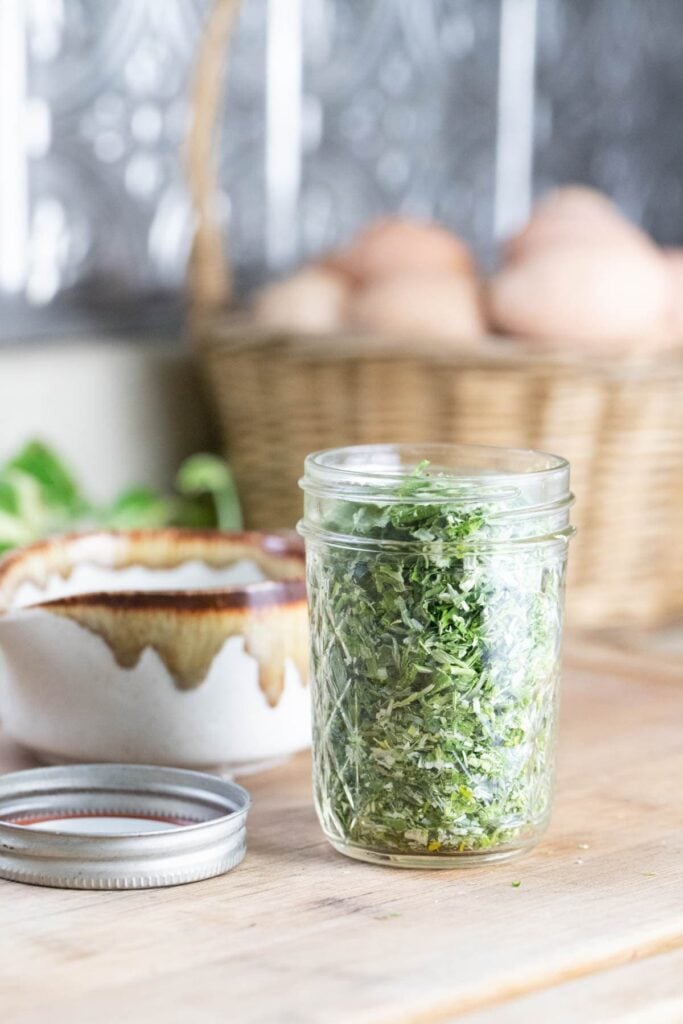
How to Make Dried Green Onion Flakes…
Dried green onion flakes are actually the finished product for me. I process all of my dehydrated green onions into flakes which I then keep with all of my seasonings and use to season food. This is really easy to do and can be done in either a blender or a food processor. Just add the dehydrated green onions and process. Store the same way… In an air-tight container.
How to Make and Use Green Onion Powder…
Making green onion powder is basically taking dried onion flakes to the next level. To do this, you might need a coffee grinder. I find that the blender or the food processor can’t really handle this task as well as a coffee grinder. Simply add the dried onions to the coffee grinder and process until they become a powder. You can then add your powder to a vegetable powder or you can store it with the rest of your seasonings and use it in place of store-bought onion powder.
Frequently Asked Questions…
Do you know what temperature your dehydrator uses? For example, the cheap Presto dehydrator that you can often find at Walmart uses a temperature of 165 degrees F. There is no way to control the temperature. 165 degrees F is the temperature that we use to dry meat and fish, it’s a bit high for vegetables and herbs. Will it work? It probably will, however, you’ll have to adjust the processing time and you might not get the best results, but yes, it will probably work.
Yes, it’s ok and normal. The white parts of the onion contain more water than the green parts so it might take them a bit longer to dry. This is why we keep them on separate trays. If you feel like the green tops are done drying, take them out and keep the tray with the white parts in the dehydrator a little longer.
1/4 cup of dried green onions will become about a tablespoon of dried green onions, and about 1.5-2 teaspoons of dried green onion flakes or powder. I processed 3 bunches of green onions here and got half a pint of green onions flakes. I hope this gives you a an idea for determining how much you need to process for your needs.
Drying green onions is a great beginner dehydrating project! They are very simple to prepare, you don’t have to blanch them or soak them in a lemon bath or whatnot… Just cut and dehydrate. In my opinion, this is really the best way to preserve green onions and it’s a useful ingredient to have on the spices shelf!
More Preserving Tutorials…
- Purple Sweet Potato Chips
- How to Dry Apples in the Oven
- Dehydrated kale Chips
- How to Dry Cayenne Peppers
- Dehydrated Orange Slices

How to Dehydrate Green Onions
Dehydrated green onions for long-term storage at room temperature.
Ingredients
- 3 bunches of green onions
Instructions
- Wash the onions, remove roots and wilted or old leaves. I usually chop the onions into pieces that are 1/2 inch long. Since the white part is thicker than the green, I slice each piece lengthwise and separate the layers of the white part. You can chop the onions any way you'd like, just try to make sure that the pieces are approximately the same so they dry evenly.
- Place the green onions on the dehydrator trays in one layer. It works best if you keep the white parts and the green parts of the onions separated since the white parts contain more moisture and it might take them a little longer to dehydrate. If you keep them separated you can remove the tray with the green tops and let the tray with the white parts stay in the dehydrator for a little while longer.
- Dehydrate the onions. There are two ways to this...
Option one: treat the green onions as a vegetable. The recommended temperature for dehydrating vegetables is 125 degrees F. If you dry your green onions at this temperature it will probably take you 5-6 hours.
Option two: treat the green onions as an herb. Many people (myself included) prefer treating green onions like an herb instead of a vegetable and choose to dehydrate green onions at a lower temperature for a longer period of time. This seems to help preserve the taste and color better. If you want to go this way, dry your green onions at a temperature of 100 degrees F for 7-9 hours. - Once the green onions are completely dry you can store them at room temperature in an air-tight container (canning jars work great).
- To make green onion flakes, process the dehydrated green onions in a blender or food processor. To make a green onion powder, process the dehydrated green onions in a coffee grinder. Store the same way, in an air-tight container.
Notes
How to Dry Green Onions in the Oven...
- Prep the onions the same way I described above.
- Place them in one layer on a baking sheet lined with parchment paper.
- Preheat your oven to the lowest temperature. Many ovens these days have a drying option. If your oven has this option turn it to 125 degrees F or even lower if possible. If your oven doesn't have a drying option turn it as low as it can go, preferably 160-170 degrees F.
- Place the baking sheet in the oven and watch it carefully. You might need to turn it or flip the onions. They should be dry in about 4 hours or so depending on the temperature.
Frequently asked questions...
- I have a cheap dehydrator (I can't control the temperature), can I use that to dry green onions?
Do you know what temperature your dehydrator uses? For example, the cheap Presto dehydrator that you can often find at Walmart uses a temperature of 165 degrees F. There is no way to control the temperature. 165 degrees F is the temperature that we use to dry meat and fish, it’s a bit high for vegetables and herbs. Will it work? It probably will, however, you’ll have to adjust the dehydrating time and you might not get the best results, but yes, it will probably work. - It seems like the green parts are drying faster than the white parts, is this ok?
Yes, it’s ok and normal. The white parts of the onion contain more water than the green parts so it might take them a bit longer to dry. This is why we keep them on separate trays. If you feel like the green tops are done drying, take them out and keep the tray with the white parts in the dehydrator a little longer. - What’s the conversion between raw and dried green onions?
1/4 cup of dried green onions will become about a tablespoon of dried green onions, and about 1.5-2 teaspoons of dried green onion flakes or powder. I processed 3 bunches of green onions here and got half a pint of green onions flakes. I hope that this gives you an idea for determining how much you need to process for your needs.
Nutrition Information:
Yield: 3 Serving Size: 1 cupAmount Per Serving: Calories: 5Total Fat: 0gSaturated Fat: 0gTrans Fat: 0gUnsaturated Fat: 0gCholesterol: 0mgSodium: 2mgCarbohydrates: 1gFiber: 0gSugar: 0gProtein: 0g



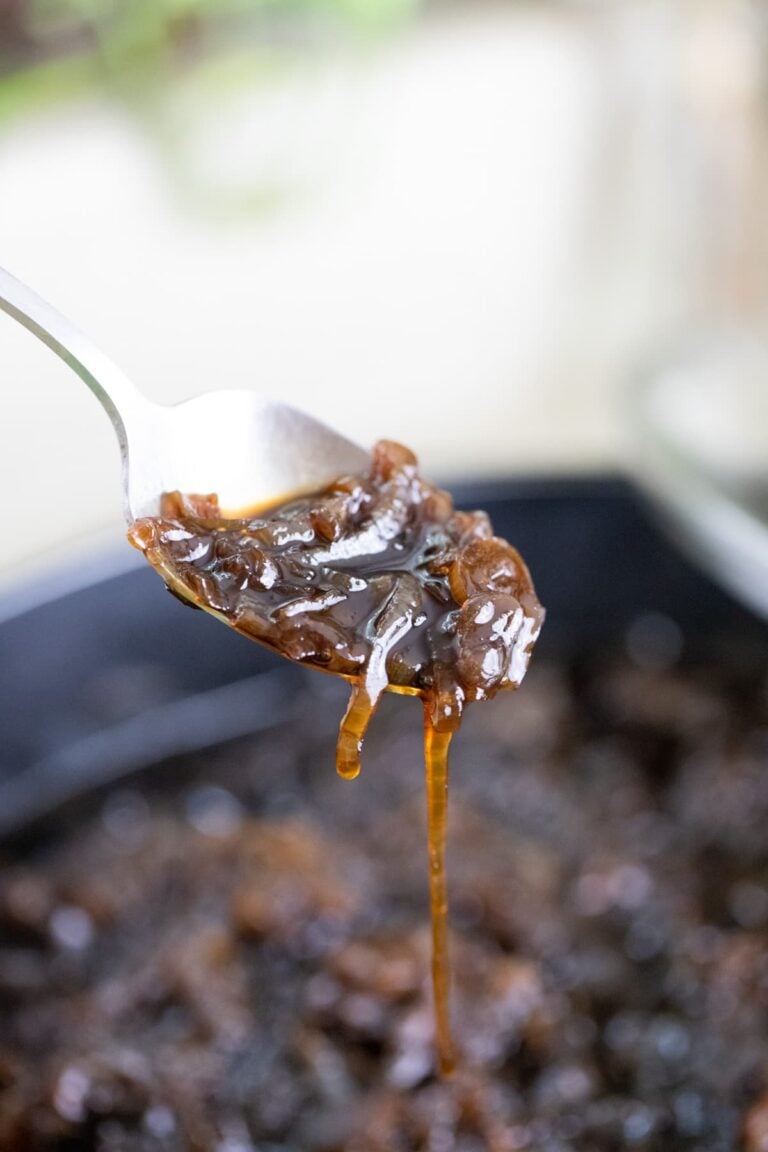
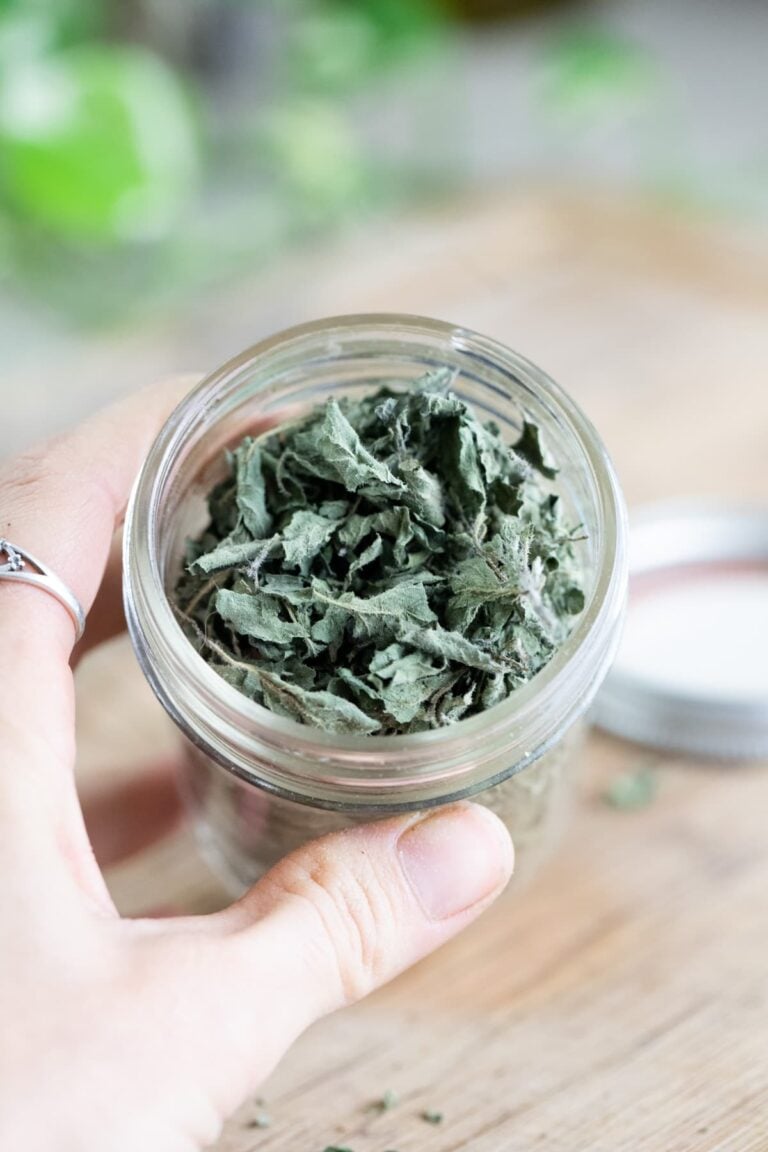
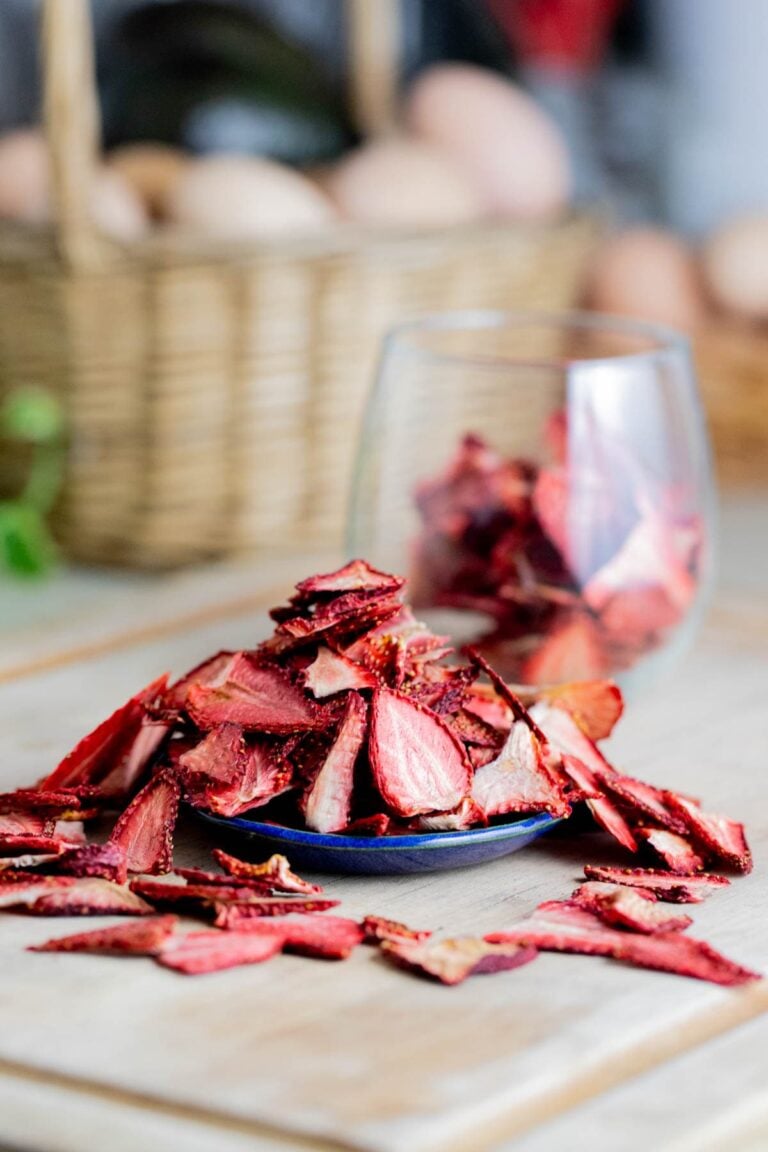
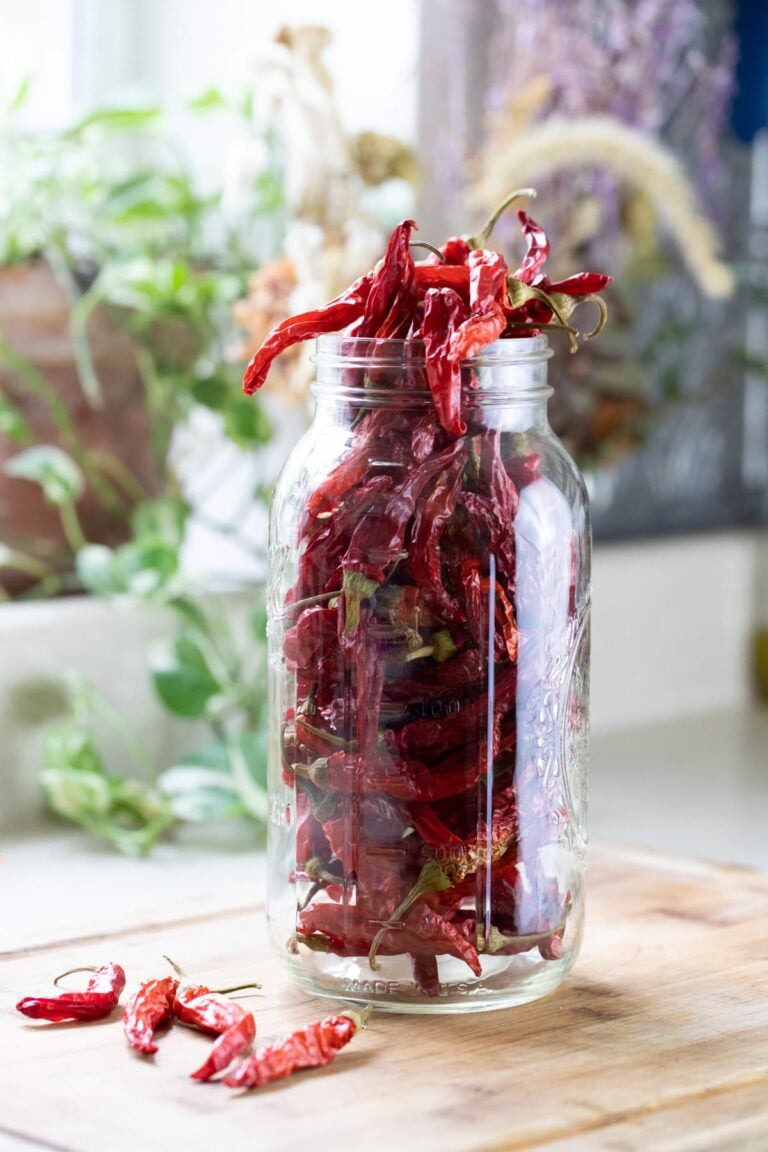
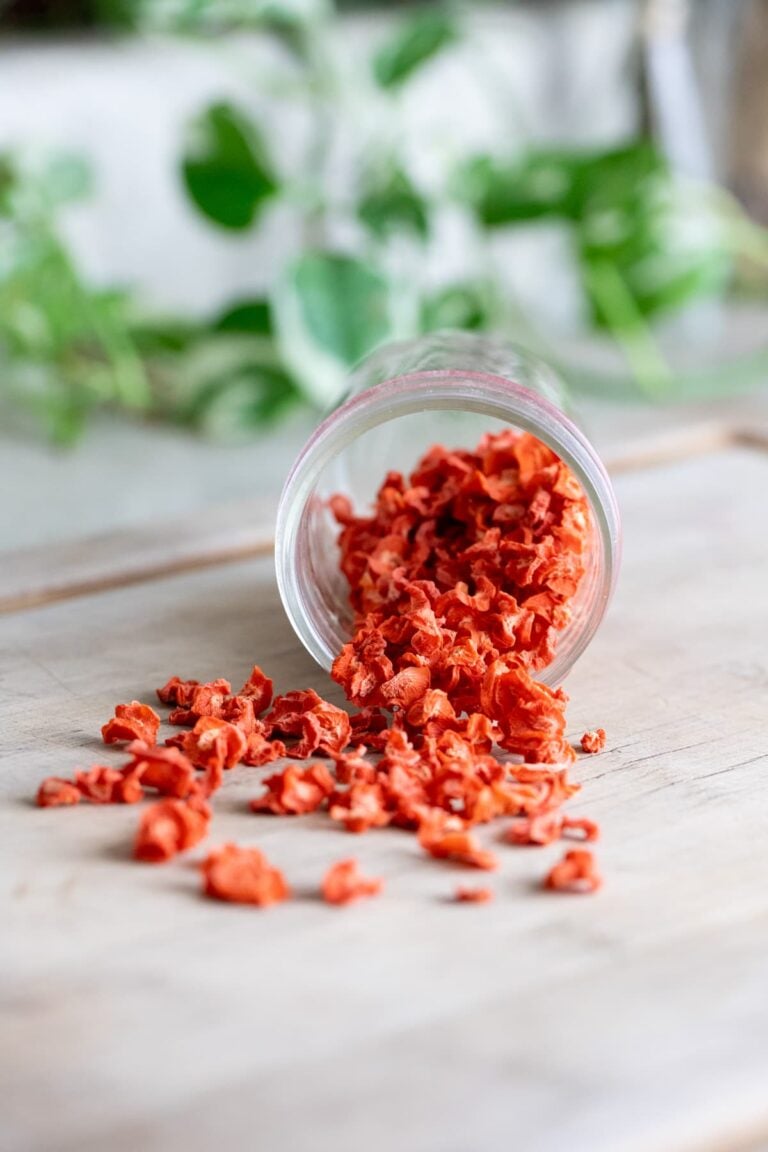
Thanks for mentioning that you need to know what temperature your dehydrator gets to. I own a small cafe, and I would like to start investing in dehydrated ingredients so they last longer. It would be nice to find some of this in bulk so it will last for a long time.
If you do it in large quantities or for business, I definitely think that you should get a good dehydrator. Don’t go for the cheap ones…
From your photo in this article, it looks as though you may have the 9-tray Excalibur dehydrator, which is the same one that we have; we highly recommend it.
We borrowed several dehydrators from people and discovered that the lack of a temperature control or being able to slide out just one drawer to check on progress was just too much to deal with. The model we have is the one with the timer on it, my brother-in-law (with two gardens) just bought the same one, and we just bought one for our daughter that also has a timer but goes to 48 hours instead of 24. I quickly tired of having to wake up in the middle of the night to turn the darn thing off, so the timer was well worth the extra expense involved. Thank you for having such thorough descriptions.
That’s exactly what I have! I didn’t mind paying a bit extra for the timer. I love it!